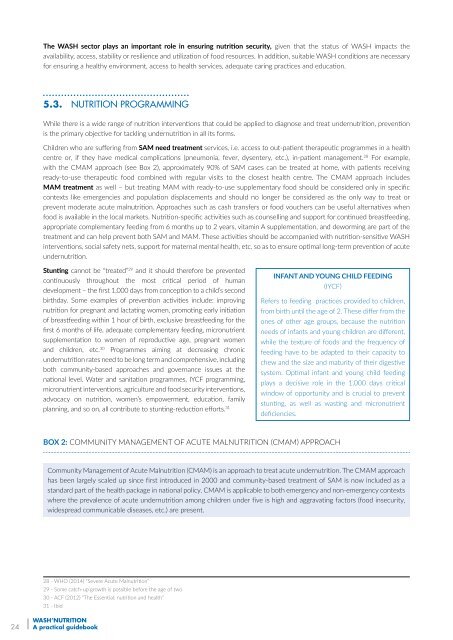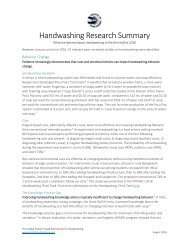WASH’ Nutrition
manuel_wash_nutrition_online
manuel_wash_nutrition_online
You also want an ePaper? Increase the reach of your titles
YUMPU automatically turns print PDFs into web optimized ePapers that Google loves.
The WASH sector plays an important role in ensuring nutrition security, given that the status of WASH impacts the<br />
availability, access, stability or resilience and utilization of food resources. In addition, suitable WASH conditions are necessary<br />
for ensuring a healthy environment, access to health services, adequate caring practices and education.<br />
5.3. nutrition programming<br />
While there is a wide range of nutrition interventions that could be applied to diagnose and treat undernutrition, prevention<br />
is the primary objective for tackling undernutrition in all its forms.<br />
Children who are suffering from SAM need treatment services, i.e. access to out-patient therapeutic programmes in a health<br />
centre or, if they have medical complications (pneumonia, fever, dysentery, etc.), in-patient management. 28 For example,<br />
with the CMAM approach (see Box 2), approximately 90% of SAM cases can be treated at home, with patients receiving<br />
ready-to-use therapeutic food combined with regular visits to the closest health centre. The CMAM approach includes<br />
MAM treatment as well – but treating MAM with ready-to-use supplementary food should be considered only in specific<br />
contexts like emergencies and population displacements and should no longer be considered as the only way to treat or<br />
prevent moderate acute malnutrition. Approaches such as cash transfers or food vouchers can be useful alternatives when<br />
food is available in the local markets. <strong>Nutrition</strong>-specific activities such as counselling and support for continued breastfeeding,<br />
appropriate complementary feeding from 6 months up to 2 years, vitamin A supplementation, and deworming are part of the<br />
treatment and can help prevent both SAM and MAM. These activities should be accompanied with nutrition-sensitive WASH<br />
interventions, social safety nets, support for maternal mental health, etc. so as to ensure optimal long-term prevention of acute<br />
undernutrition.<br />
Stunting cannot be “treated” 29 and it should therefore be prevented<br />
continuously throughout the most critical period of human<br />
development – the first 1,000 days from conception to a child’s second<br />
birthday. Some examples of prevention activities include: improving<br />
nutrition for pregnant and lactating women, promoting early initiation<br />
of breastfeeding within 1 hour of birth, exclusive breastfeeding for the<br />
first 6 months of life, adequate complementary feeding, micronutrient<br />
supplementation to women of reproductive age, pregnant women<br />
and children, etc. 30 Programmes aiming at decreasing chronic<br />
undernutrition rates need to be long term and comprehensive, including<br />
both community-based approaches and governance issues at the<br />
national level. Water and sanitation programmes, IYCF programming,<br />
micronutrient interventions, agriculture and food security interventions,<br />
advocacy on nutrition, women’s empowerment, education, family<br />
planning, and so on, all contribute to stunting-reduction efforts. 31<br />
Infant and Young Child Feeding<br />
(IYCF)<br />
Refers to feeding practices provided to children,<br />
from birth until the age of 2. These differ from the<br />
ones of other age groups, because the nutrition<br />
needs of infants and young children are different,<br />
while the texture of foods and the frequency of<br />
feeding have to be adapted to their capacity to<br />
chew and the size and maturity of their digestive<br />
system. Optimal infant and young child feeding<br />
plays a decisive role in the 1,000 days critical<br />
window of opportunity and is crucial to prevent<br />
stunting, as well as wasting and micronutrient<br />
deficiencies.<br />
BOX 2: Community Management of Acute Malnutrition (CMAM) approach<br />
Community Management of Acute Malnutrition (CMAM) is an approach to treat acute undernutrition. The CMAM approach<br />
has been largely scaled up since first introduced in 2000 and community-based treatment of SAM is now included as a<br />
standard part of the health package in national policy. CMAM is applicable to both emergency and non-emergency contexts<br />
where the prevalence of acute undernutrition among children under five is high and aggravating factors (food insecurity,<br />
widespread communicable diseases, etc.) are present.<br />
28 - WHO (2014) “Severe Acute Malnutrition”<br />
29 - Some catch-up growth is possible before the age of two<br />
30 - ACF (2012) “The Essential: nutrition and health”<br />
31 - Ibid<br />
24<br />
<strong>WASH’</strong><strong>Nutrition</strong><br />
A practical guidebook



